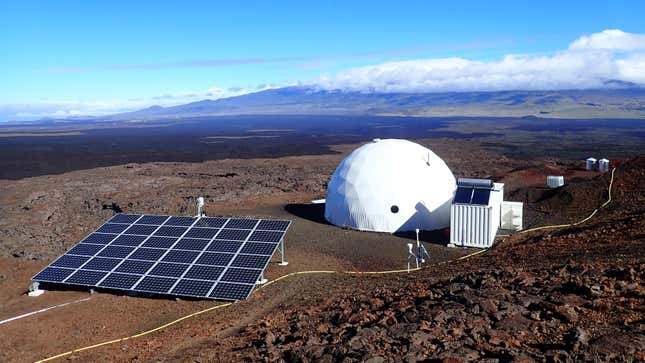
Moonwalking on Mauna Loa. That’s been the name of the game for the astronaut candidates of the HI-SEAS habitat atop the Hawaiian volcano, and today, team members shared the latest updates on their extreme mission at the European Geosciences Union’s general assembly.

HI-SEAS, or the Hawaii Space Exploration Analog and Simulation, is a mock extraterrestrial base that has been operational since 2013. It offers scientists, engineers, and members of other fields eager to cut their space-traveling teeth the opportunity to live on the mountain. The astronauts-in-training live 8,200 feet up the mountain for up to a year, conducting business as they would on a permanent base on the Moon or Mars. Their work offers insight on how humans would actually manage to live off-planet in the future.
“There is so much that we still need to learn from how humans interact under these challenging conditions, particularly on how to create a space family environment for everyone to get along and work together well,” said Michaela Musilova, the director of HI-SEAS, in an email. “Then, we also need to figure out how to solve problems that are likely to occur on long-duration missions, which is something that has plenty of room for improvement.”
To that end, HI-SEAS recently ran an experiment in hydroponics to grow lettuce within the habitat, an endeavor performed on the International Space Station in 2015. When storms arrive on the islands, the team puts the habitat in low-power mode, as it relies on a solar-powered generator.
The analog astronauts, as they’re called, don’t get bombarded with radiation and don’t deal with microgravity, but they do dress the part of lunar or Martian explorers. Team members wear space suits whenever they venture beyond the cramped 1,200-square-foot habitat they share, complete with a heads-up display and limited oxygen supplies. Musilova said some of the biggest technical challenges come on those trips outside the base, where suits built to protect astronauts in “space” can be clunky for the geological, volcanological, and astrobiological work the team performs. These excursions take place on the Martian-like soil of Mauna Loa and in the volcano’s lava tubes, canals where molten rock once flowed.
“The work environment in lava tubes is very challenging,” Musilova said. “Analog astronauts have to descend into caves with sharp rocks all around them. Sometimes they need to crawl in some of the narrow parts of tubes or climb up near vertical walls. Then, they need to perform research, such as collecting sensitive microbiological samples or drilling with special equipment.”
Along with other simulated habitats at NASA’s Johnson Space Center and elsewhere, HI-SEAS is part of the intensifying effort to get humans ready for living on other worlds, which could well be soon. NASA recently selected SpaceX as the company to build its Artemis lunar lander. At some point, our visits will have to become stays if human space exploration is to go beyond its 20th-century heyday.